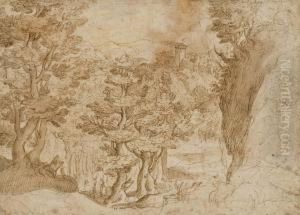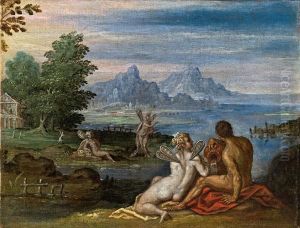Ludovico Pozzoserrato Paintings
Ludovico Pozzoserrato, also known as Lodewijk Toeput, was an Italian painter of the late Renaissance period. Born around 1550 in the town of Treviso, Italy, Pozzoserrato is a figure who embodies the cross-cultural exchanges in the European art world of his time. His work is primarily associated with the Venetian school, yet it is his journey to the Northern regions of Europe that distinguishes his artistic legacy.
Pozzoserrato moved to the Southern Netherlands, now Belgium, in the late 16th century, where he became deeply involved in the Flemish artistic community. This relocation was pivotal for his artistic development, allowing him to fuse the rich colorism and grandeur of Venetian painting with the detailed landscapes and genre scenes characteristic of Flemish art. His paintings often depict pastoral scenes, religious subjects, and mythological themes, showcasing his versatility and adaptability to different artistic tastes and traditions.
One of Pozzoserrato's significant contributions to art was his ability to blend the Italian Renaissance's emphasis on perspective and proportion with the Northern Renaissance's attention to detail and naturalism. This synthesis created works that were both harmonious and richly detailed, appealing to patrons across Europe. Despite his Italian origins, Pozzoserrato's work in the Low Countries earned him a reputation as an important mediator between the Italian and Flemish artistic traditions.
Pozzoserrato's legacy is also marked by his influence on local artists in the regions where he worked. Through his teaching and interaction with other painters, he helped disseminate Italianate styles and techniques among Flemish artists, contributing to the development of a more international European art scene during the late Renaissance and early Baroque periods.
Ludovico Pozzoserrato passed away in 1605. While he may not be as widely recognized as some of his contemporaries, his work remains an important testament to the cultural and artistic exchanges that shaped European art during his lifetime. His paintings are preserved in various museums and collections, serving as enduring examples of the fruitful dialogue between the artistic traditions of Italy and Northern Europe.

